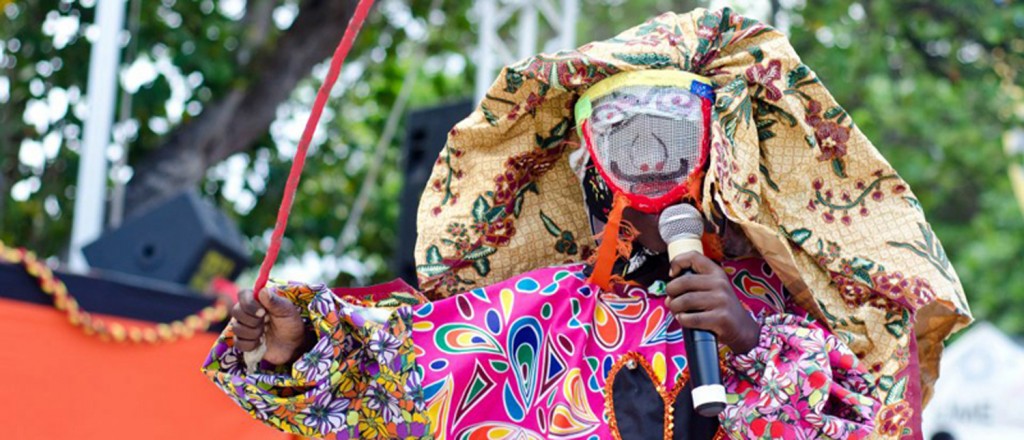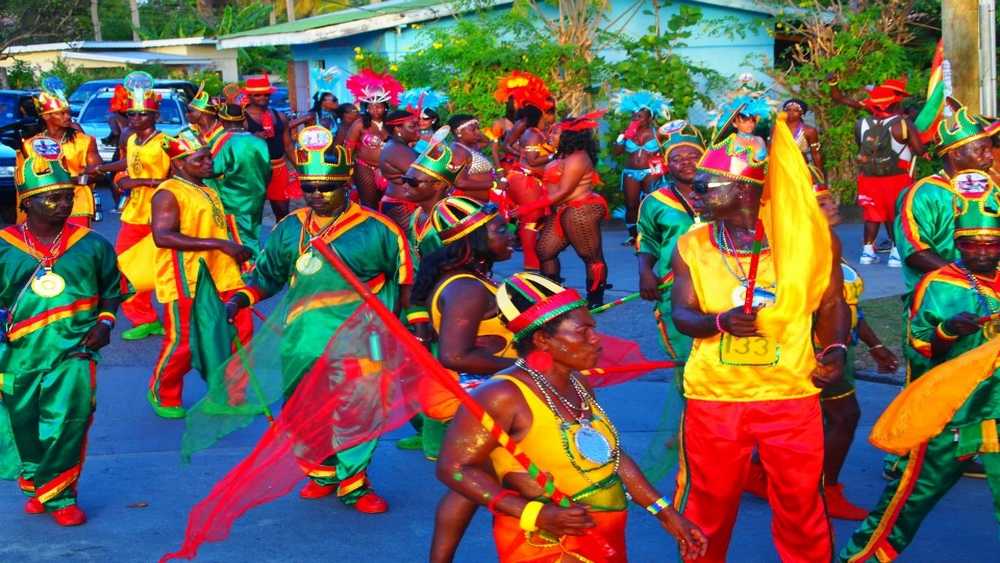|
Getting your Trinity Audio player ready...
|
Reading Time 4 mins
Big Drum Nation interviews Nicholas Cox
February 2015
Big Drum Nation (BDN): This year the Carriacouan Carnival comes under this scintillating theme, “Celebrating the Legacy of Shakespeare: Embracing the Splendor of our Traditional Mas”, what is the Shakespeare Mas?
Nick Cox (NC): As I know it Shakespeare Mas stems from the use of speeches adapted from the writings of William Shakespeare in a duel of words between masqueraders. The theme appears to be battling European armies who attempt to outwit each other using speeches from Shakespeare’s plays, most commonly “Julius Caesar.”
The costumes are colorful and mask the entire body. Small, body bells are attached to the costumes to jingle with every movement.
The face mask is made of a fine wire mesh, with eyes, nose and mouth painted on and positioned to give the impression of looking away from the opponent, a form of deception. A group of small circular mirrors, two to three inches in diameter, are attached to the front of the chest and upper abdominal areas.

Laluna. “Carriacou Shakespeare Mas”. http://www.laluna.com/blog/carnival-across-the-caribbean/ (accessed February 24, 2015).
A thick head cushion the “Kotta”, made from hanging tree roots, is covered by the “Crown”, which is a glorified cape, made of colorful fabric, glued to coarse packaging paper. The Kotta acts as a shock absorber for being hit on the head by the weapon, the “Stick.” The stick is a cylindrical, wooden club, approximately one yard long and one inch in diameter. The crown was good protection from being hit by the secret weapon, the “Bull Pistle”, about the same dimensions as the stick, but flexible and springy.
Early on the morning of Shrove Tuesday (the day preceding Ash Wednesday)[1], armies of masqueraders gather in their villages, spar with each other. The battle is a combination of the Shakespeare speeches and the African Stick Fighting Kalenda. Respected elders oversee the sparring like referees, to ensure it does not get out of hand. They then move on as a unit to the challenge the next army on the way to town accompanied by onlookers and supporters.
When the army is some fifty yards from the battlefield, usually a cross roads, they would have their gear inspected and strategize the attack. One masquerader would attack at full running speed and be met by a chosen masquerader from the waiting army. Their sticks will touch violently and the insulting duel of speeches will begin. The masquerader should be able to quickly and eloquently respond with an appropriate speech. The other masqueraders will join in and duel with the members of the opposing army.
My favorite speech is from “Julius Caesar”, scene one, on a Roman street when Marrulus tells off/insults the commoners;
” Wherefore rejoice? What conquest brings he home?
What tributaries follow him to Rome,
To grace in captive bonds his chariot-wheels?
You blocks, you stones, you worse than senseless things!
O you hard hearts, you cruel men of Rome …”
Another popular speech from “Julius Caesar” is Marcus Antonius at Julius Caesar’s funeral;
” Friends, Romans, countrymen, lend me your ears;
I come to bury Caesar, not to praise him.
The evil that men do lives after them;
The good is oft interred with their bones;
So let it be with Caesar …”
After about half an hour of “fighting”, both armies will join unmask, join forces and move on to the next battlefield on their way to town. In town the grand battle is fought.
BDN: Going back to your childhood, did the mask-wearing Shakespeare character inspire fear in you?
NC: The Shakespeare masqueraders did not cause fear in me. They were looked at as brave warriors with great give of “speech making”. The movements, the grandstanding, the accents in the speeches, the noise of the bells, the colors of the costumes, and the bull pistle fights were all very entertaining. When the battle was over, we all got to see the faces of the masqueraders.
BDN: Why is it important to “embrace” the Shakespeare mas and as well other Carnival characters?
NC: The artistry of the masqueraders developed naturally and is therefore culture. It gives us a glimpse of the history of our people. Many masqueraders even into the 1970s were completely illiterate, but recited perfect and appropriate speeches. It is cultural theatre, resulting from a clash of Africa meeting Europe, though not under the best of circumstances. The masquerades are chapters in a living history book.
Carriacou Grand View Hotel. “Discover Vibrant Culture”. http://www.carriacougrandview.com/thingstodo.html/ (accessed February 24, 2015).
BDN: Carnival is a colorful overthrow of conventions: Is this inversion a good thing for the moral/psychological health of a community?
Carnival gives a platform for anyone to create their stage and play the role that their chose. This is indicative in the many individual masquerades that are acted out in the villages, door to door and on the streets and the crowds of the towns. It is a theatre that puts many a spin on the realities of life and beliefs of the communities. Importantly, no one is excluded from being a player. Even the shy get on stage using the mask. Morality, if taught in the home, prepares one to deal with the reality that is exposed on the carnival stage. Some masquerades are meant to instill fear. That too is a reality that members of the society must be prepared to deal with.
BDN: Can we use Carnival characters to link our past to our present? And what value might there be in such linking?
I repeat here that our history is exposed in the characters of carnival. Carnival is the theatre of the people. No one owns it. The stage is wherever the masquerader decides it should be. Everyone has a chance to tell their story on carnival day.
[1] Pancake Day in Britain.
Nicholas Cox is one the leaders of Carriacou and Petite Martinique 2000 Inc., a Brooklyn-based not for profit organization made up of Carriacouans and Petite Martiniquans living in the United States.

